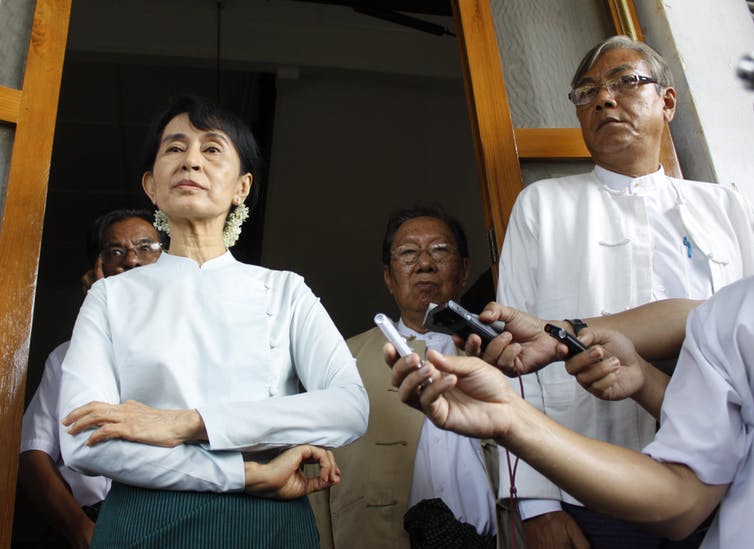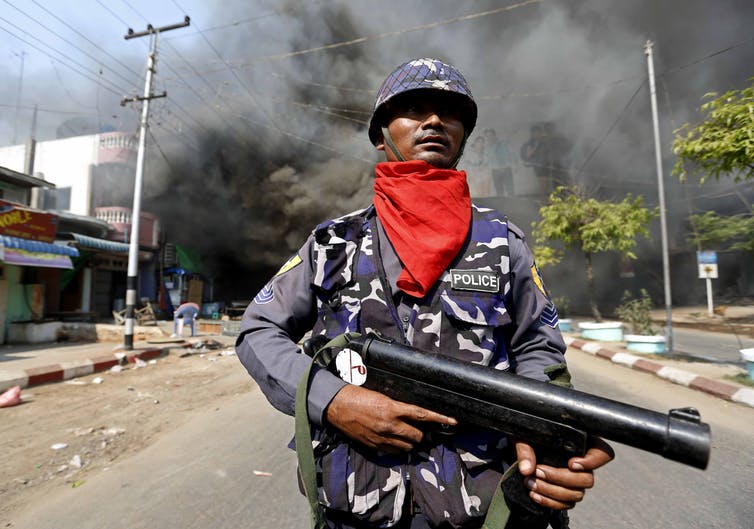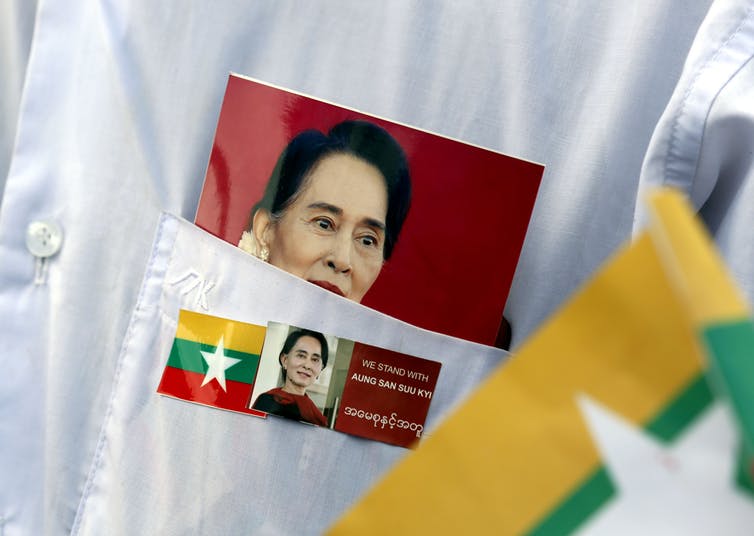Eyewitness: The Rohingya Horrors and [Nobel Peace Laureate] Aung San Suu Kyi’s Whitewash
NOBEL LAUREATES, 20 Nov 2017
Ellen Wiles – The Conversation
16 Oct 2017 – It was a bright autumn morning, and I had just dropped off my two children at nursery and was scrolling through Twitter, when I spotted a video of another mother’s two children.
The youngest was a one-year-old boy, the same age as my own youngest; the other, his nine-year-old sister, had been carrying him for miles. She was weeping, the tears from her terrified eyes indistinguishable from the rain pouring off her short black hair and drenched clothes. A Rohingya child, she had fled from the one of the many scenes of horror inflicted by the Myanmar military on Muslim areas across the country’s beleaguered Rakhine state, where hundreds of villages have been burned to the ground and where fleeing people have been killed by landmines and children beheaded. As I struggled to get my front door key into the lock, I found I was crying too.
The UN has called the Myanmar military’s campaign against the Rohingya, involving the burning of hundreds of Muslim villages in Rakhine State and targeting people with landmines as they ran, a “textbook example of ethnic cleansing”. More than half a million people have fled into Bangladesh – many of them children who saw their parents murdered. The UN has warned of a further influx.
For those fairly unfamiliar with Myanmar, the situation is not just horrific, but bizarre. Myanmar was supposed to be firmly on the road to democracy, and yet now the military is out murdering again. Buddhism has an international reputation as a peaceful religion – and yet the vicious violence is being perpetrated by the military in the name of Buddhist nationalism.
And then there’s the sight of Nobel Peace Prize-winning human rights icon Aung San Suu Kyi, the head of government in all but name, publicly whitewashing the situation. She has failed, not just to condemn, but even to recognise the atrocities. She has declined to acknowledge the existence of the Rohingya except as part of a terrorist movement or to call for UN investigators to be allowed in to observe the situation. While she has now proposed that anyone “verified as a refugee” would be accepted back, it is hard to see what reassurance this might offer to Rohingya people who are not considered citizens in Myanmar and when no guarantee has been offered for their future safety.
All this has been happening in a country I was living in just four years ago, when the world was full of hope for its peaceful, democratic future. I only wish I were surprised.
Decades of repression
Myanmar’s military has a five decade-long track record of inflicting violence upon civilians in the name of Buddhist nationalism, a principle written into the country’s constitution. In Rakhine state, the military has twice before attempted “ethnic cleansing” of Rohingya Muslims, first in 1992 and then in 2012. Many of the country’s other ethnic and linguistic minorities have been similarly targeted.
During the decades of repressive military rule, the government-run newspaper, The New Light of Myanmar, would regularly feature articles about one of the military leaders opening yet another bright, golden pagoda for the local population to worship in and be grateful for, even as terrible events were unfolding in other regions. I have seen some of the results first-hand: ten years ago, I was living and working in Thailand in a refugee camp where 40,000 Karenni people were trapped after fleeing from burning hill villages and mass killings in Myanmar.
Then, almost out of the blue, the regime announced in 2010 that Myanmar would begin a transition towards democracy. Suu Kyi was released from house arrest and other notable political prisoners freed. Onlookers were astounded but sceptical – they remembered the 1990 election, in which the National League for Democracy (NLD) party won 81% of seats, only to see the results disregarded. But remarkably, this time, the military appeared to follow through. In 2012, it permitted a by-election in which Suu Kyi was allowed not only to run for office, but to win it. A general election was promised within three years.
Keen to lend a hand in this exciting new phase, and to finally see inside this secretive country, I moved to Myanmar at the start of 2013 to work on a human rights legal project, training local lawyers in Yangon, the former capital. And almost as soon as I stepped off the plane, I was entranced.
Hope for democracy
On the one hand, arriving in Yangon was like stepping back in time. Life bubbled busily and fragrantly on the streets, men and women alike wore colourful longyi wrap-arounds rather than jeans and there was barely a mobile phone in sight. The air seemed to vibrate with happy anticipation of the future. The junta was still in control of parliament, but a full general election was promised before long. Most people I spoke to expressed adulation for “The Lady” and felt freer to express themselves than ever.
I was so captivated by those I met in Yangon that I ended up writing a book about them. Myanmar’s writers were particularly fascinating to me, initially because it was so difficult to get access to their work. In my first few days in the country, I searched bookshops for fiction in translation to help me get a better sense of the place, but found hardly any. When I finally met some writers in person, they uncovered a trove of true stories about creating and informing and surviving under one of the world’s most repressive regimes. Several I met had spent time in prison for daring to cross invisible lines. Almost all of them were passionate about literature and free expression, as well as about human rights, liberty and democracy more widely.
But one day, in the course of a friendly chat, I got a shock, a glimpse of the darkness behind the country’s bright, gold-flecked surface.
I had been having lunch with one of my new friends, a gregarious writer, in one of her favourite cafes on the edge of an urban lake. She had just been telling me vivid stories about her experiences under censorship, including her time in prison, and how she intended to use the life ahead of her to tell stories and speak up against oppression, particularly against women. I was impressed and inspired.
We were saying our goodbyes, and in maternally hospitable mode she insisted on flagging down a taxi for me. One duly pulled up, but she shook her head violently, frowning, and waved it on again. I looked at her, confused. “Never get in with a Muslim driver,” she told me. “Filthy.” I was momentarily lost for words. She promptly flagged down another one. A Buddhist driver, apparently. I got in obediently and waved to her with a mechanical smile.
From then on, I began to notice an uptick in news articles about Muslims, and the hate speech directed against them. A notorious nationalist Buddhist monk, Ashin Wirathu, had recently been released from jail for inciting violence against Muslims and had promptly resumed his activities as leader of a nationalist campaign called 969, which aimed to “defend” the Buddhist values of Myanmar against what was said to be an expanding Islamic presence. The campaign discouraged relationships between Buddhist women and Muslim men and sought to persuade businesses not to deal with Muslim customers; shopkeepers around town were busy putting signs up behind their counters. It all felt sinister to say the least.
Witness to violence
A few months later, my husband and I decided we’d do some travelling to see more of the country, and would head almost as far north as we could legitimately go. Some regions were still closed to visitors, including most of Rakhine State, where there had been clashes between Muslims and Buddhists the year before. Other states were off-limits too, among them Shan and Karen, where populations had their own languages and cultures and wanted to preserve them, contrary to the regime’s preference for uniformity.
Just before we left, news broke of more violence involving Muslims, this time starting in a little town called Meikhtila. It all started with a dispute between a shopkeeper and a Muslim customer over a gold hairpin, which attracted attention and escalated until a mob formed and destroyed the shop. Later that day, a Buddhist monk was doused in petrol and burned, sparking violence that killed 40 people and injured more than 60, most of them Muslims.
The BBC posted a video showing police apparently standing by as rioters, including Buddhist monks, torched houses and killed Muslim students in Meikhtila in central Myanmar. About 9,000 people were displaced before military troops were sent in to calm the situation. There were rumours flying around that the military had started burning down Muslims’ houses, even that troops had incited violence deliberately. One person told me that they had seen a horde of men dressed in black ride motorbikes around one night while the internet was suspiciously down.
Whatever the truth, the situation seemed to calm down, and we reckoned it was safe to proceed.
We took a snail-like but stunning train journey up to Pyin Oo Lwin, which had been a colonial hill station retreat, then headed to Mandalay, where we dined on delicious dhal in the street. Our final stop on this trip was going to be the picturesque Inle Lake in the Shan hills, which required us to change trains and stay overnight in a town called Thazi. We hadn’t quite clocked how close that was to the epicentre of the recent violence.
We arrived shortly after sunset and got off the train to darkness and eerie silence. A couple of people who looked like locals got off at the same station, but scuttled away. There were no taxis waiting, and nobody trying to sell anything at all to these tourists. It was clear that there were hardly any buildings near the station and that the centre of the town must be some way off down the only visible road. But weirdly, there were no lights to be seen in the distance. We had booked a room in the only guesthouse in town which was supposedly on the main street. There would be no more trains until the next day. We would just have to find it on foot.
As we set off, a man appeared out of the shadows, looking worried and pointing to his rickshaw. He whispered the price to take us to town. We nodded in eager relief, handed over the money and climbed aboard. He cycled silently down the deserted road, then pulled up at a junction, got off and took our bags from us, putting them down by the side of the road. “I have to leave you here,” he whispered hoarsely. Surprised, we got off and thanked him. “Do you know where the guesthouse is?” I asked. He shook his head and was gone.
We walked slowly along the main street. It was only 7.30pm, but nobody was around. No pedestrians, no bikes, no cars, no lights visible except through cracks around doors and shutters – we were utterly alone. We walked silently on down the street, hoping that a door would be thrown open and a welcoming, illuminated face would call out, saying he’d be waiting for us. Nothing.
Finally, we spotted an old sign nailed above a door saying “guesthouse”. Relief! We knocked, and knocked again: silence. There was definitely light around the window shutters. We called out, “Hello? Is anyone there?”: still silence. We began to panic. What was going on, and what on Earth were we going to do if we weren’t going to be let into the only legal place to stay in town?
But then we heard footsteps. The lock jiggled, and the front door opened. A man stared out at us, and then past us. His face was not welcoming; it was scared, and not of us. “You booked to stay?”, he whispered. We nodded, and he beckoned us in.
He led us upstairs into an ancient, peeling box room where he took down our passport details. We asked him what was going on and he stopped writing and looked at us. “There is a curfew,” he said. “Because of the violence. Just down the road. You didn’t hear about it?” It was only then that we realised quite how close to the violence we were. We hadn’t thought to check about curfews. “Nobody is allowed to have any lights on after sunset in this region, or be outside at all,” he said. “I am a Muslim myself. We Muslims are very scared. Bad, bad things are being done to us. We have nobody to help, nothing.”
We nodded, then crept up to sleep in our flimsy, filthy single beds in a room that couldn’t have been done up in any way for the past 50 years. So much for the transition, for the racing economy of the next “Asian Tiger”, for the hope of peace and freedom from fear.
Shortly after we returned to Yangon, an orphanage attached to a mosque was set on fire in the centre of the city, just around the corner from where we were living. Thirteen children were killed. When a police officer speaking at the scene said the fire was triggered by an electrical short “and not due to any criminal activity”, he was jeered by the crowd. Nobody was arrested, and after a few days the street opened again.
Constitutional failure
When I left Myanmar, I still held out hope that the general election in 2015 would improve things and that Suu Kyi would speed up the transition and usher in reforms to prevent violence and hate speech from escalating. But as the campaign got underway, it became clear there were major obstacles.
Chief among them was the constitution, which the military government made clear it would not amend in the foreseeable future. One of its clauses prohibits any candidate with a foreign spouse or foreign-born children from becoming president, a measure designed specifically to bar Suu Kyi from taking the helm. Another provision guarantees the military enough seats in parliament to give it a veto and to exert control over security and border affairs. Still others protect the primacy of Buddhism over other religions and deny rights to those deemed to be non-citizens – notably the Rohingya.
During the course of her election campaign, Suu Kyi lobbied in vain to change the presidential eligibility clause, but the constitution remains intact today. By taking power once elected, she effectively acquiesced to it (she settled for the new title of “state counsellor”.)
Suu Kyi’s silence
Given that military violence against Rohingya Muslims is worse that it has ever been – which is saying something – why has Suu Kyi offered no words either to condemn that violence or to support the protection of their rights? Of course, she is in a tight spot. Because of the control the military retains, there is little she can do practically to stem their violence – she has no authority to command troops. As for what she could say, she probably believes that to admit publicly that Rohingya civilians have been attacked by the military – not to mention that they are the targets of ethnic cleansing – would be enough to trigger a coup.
Suu Kyi almost certainly believes that to effect badly needed democratic change she needs to remain in government, at any cost. But there comes a point where democratic legitimacy is completely lost. Ethnic cleansing is undoubtedly past that point.
A further flaw with this notion of Suu Kyi’s role is the idea – held on to not only by her but by many in international governments – that the future of Myanmar’s democracy depends on her personally retaining office.
In truth, a democratic party is needed; not one person. And judging by her performance so far, she may in fact be more hindrance to her party than help. Rather than nurturing or empowering her colleagues, she has earned a reputation as a dictatorial micro-manager. No other policymakers have been allowed in her cabinet, and those working with her have said that, under her reign, the “government has become so centralised, there is complete fear of her”. It’s hard to miss irony of her own oft-quoted words:
It is not power that corrupts but fear. Fear of losing power corrupts those who wield it and fear of the scourge of power corrupts those who are subject to it.
Then there’s the matter of her personal beliefs. It is by no means clear that even if she could, she would speak out in support of Rohingya Muslims as deserving equal rights in Myanmar. Her party’s spokesperson, Win Htein, has stated on the record that she has no sympathy for the Rohingya. She blocked Muslims from running for parliament in 2015 and was silent when a prominent Muslim adviser and friend of hers was assassinated ten months into office. She has voiced no concern over the explicit primacy of Buddhism in the constitution and, on her watch, Buddhist nationalism has increased, not diminished.
As she will be well aware, the majority of people in the country who elected her party to power are not coming out in support of the Rohingya. Fear clearly plays a part in this, but so does hatred.
When her supporters turned out in force to support her recent speech, they were not clamouring for her to speak up for the Rohingya – quite the opposite. Burmese Buddhists have assembled to block aid deliveries to fleeing Muslims.
Endemic racist attitudes underpinning the violence against the Rohingya must be tackled from the top if the situation in the country is to improve, and if Myanmar’s transition towards democracy is to get back on track.
Suu Kyi needs to be brave and speak out. As Desmond Tutu said in his open letter to her, “silence is too high a price”. If necessary, she must accept that her attempt to work alongside the military has failed, and resign. That would at least remind her electorate that a genuine democracy cannot tolerate this kind of violence and hatred. Whether their leader stays or goes, the younger generation of NLD politicians and activists must find a way to redeem their party’s reputation and make their democracy viable. This is a mountain to climb, but there are talented younger people capable of scaling it. I have met several of them.
In the meantime, the horror of the situation has made me think twice about going back to Myanmar. I have been invited to speak at the Irrawaddy Literary Festival in November, of which Suu Kyi is a patron. If I still go, I anticipate some tense conversations. I might even have to point certain people in the direction of that video.
_____________________________________________
 Ellen Wiles is a writer and PhD candidate, University of Stirling.
Ellen Wiles is a writer and PhD candidate, University of Stirling.
Republish The Conversation articles for free, online or in print, under Creative Commons license.
Go to Original – theconversation.com
DISCLAIMER: The statements, views and opinions expressed in pieces republished here are solely those of the authors and do not necessarily represent those of TMS. In accordance with title 17 U.S.C. section 107, this material is distributed without profit to those who have expressed a prior interest in receiving the included information for research and educational purposes. TMS has no affiliation whatsoever with the originator of this article nor is TMS endorsed or sponsored by the originator. “GO TO ORIGINAL” links are provided as a convenience to our readers and allow for verification of authenticity. However, as originating pages are often updated by their originating host sites, the versions posted may not match the versions our readers view when clicking the “GO TO ORIGINAL” links. This site contains copyrighted material the use of which has not always been specifically authorized by the copyright owner. We are making such material available in our efforts to advance understanding of environmental, political, human rights, economic, democracy, scientific, and social justice issues, etc. We believe this constitutes a ‘fair use’ of any such copyrighted material as provided for in section 107 of the US Copyright Law. In accordance with Title 17 U.S.C. Section 107, the material on this site is distributed without profit to those who have expressed a prior interest in receiving the included information for research and educational purposes. For more information go to: http://www.law.cornell.edu/uscode/17/107.shtml. If you wish to use copyrighted material from this site for purposes of your own that go beyond ‘fair use’, you must obtain permission from the copyright owner.



